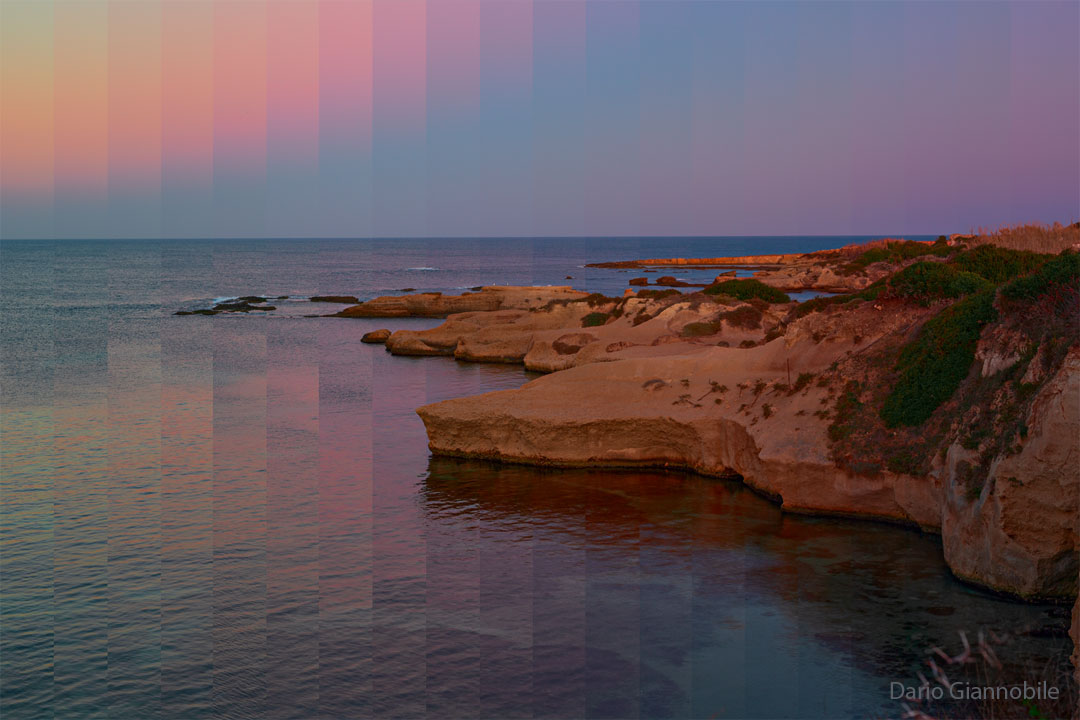28. February 2024
暗暝 ê 天色

探索宇宙1!逐工會揀一幅無仝款 ê 影像抑是相片,𤆬你熟似咱這个迷人 ê 宇宙,閣有專業天文學者2為你3解說4。
- 原始文章:Shades of Night
- 影像來源 kah 版權:Dario Giannobile
- 台文翻譯:An-Li Tsai (NSYSU)
[漢羅] 暗暝 ê 天色
暗暝 ê 時陣,天空是按怎變暗去--ê? Tī 無仝階段,會有無仝款 ê 特殊色水 ùi 地平線湠出來。 這張影像 ùi 倒爿 到 正爿,是日頭落山了後,tùi 愈來愈暗 ê 黃昏天色 連紲 翕 20 張,才 kā in ê 長條影像接起來 ê 組合影像。 相片是頂個月 tī 意大利 Sicily 島 ê Syracuse 市 翕--ê,翕相 ê 方向是 日頭 ê 相對面。 相片上倒爿是日落進前 ê 天空。 正爿彼寡 顯目 ê 光帶,包括 金星帶、藍帶、地平帶、kah 紅帶。 地球烏影 peh 起來 了後,光帶 ê 色,就會因為日光直接反射、多次反射、kah 屈折,產生無仝色。 日光直接反射,是反射 地球大氣 內底 ê 空氣 kah 煙霧質。 多次反射,有當時仔會 tī 產生 紅化現象 ê 日落 彼陣出現。 實際上,這寡光帶可能會湠--開,變甲足歹認--ê,而且 in ê 色嘛會受著 日落附近 ê 色 ê 影響,煞改變。 落尾,日頭 完全沉落去 地平線下底,天色嘛變暗去。 毋過莫絕望,這規个過程會 tī 透早 日頭 peh 起來 ê 時陣,顛倒反 閣出現一擺。
[POJ] Àm-mê ê Thiⁿ-sek
Àm-mê ê sî-chūn, thian-khong sī-án-nóa piàn àm--khì--ê? Tī bô-kâng kai-tōaⁿ, ē ū bô kāng-khoán ê te̍k-sû sek-chúi ùi tē-pêng-sòaⁿ thòaⁿ--chhut-lâi. Chit-tiuⁿ iáⁿ-siōng ùi tò-pêng kàu chiàⁿ-pêng, sī ji̍t-thâu lo̍h-soaⁿ liáu-āu, tùi lú-lâi-lú àm ê hông-hun thiⁿ-sek liân-sòa hip 20 tiuⁿ, chiah kā in ê tn̂g tiâu iáⁿ-siōng chiap khí-lâi ê cho͘-ha̍p iáⁿ-siōng. Siòng-phìⁿ sī téng kò goe̍h tī I-tá-lī Sicily tó ê Syracuse chhī hip--ê, hip-siòng ê hong-hiòng sī ji̍t-thâu ê sio-tùi-bīn. Siòng-phìⁿ siōng tò-pêng sī ji̍t-lo̍h chìn-chêng ê thian-khong. Chiàⁿ-pêng hit-kóa hiáⁿ-ba̍k ê kng-tòa, pau-koat Kim-chheⁿ-tòa, Nâ-tòa, Tē-pêng-tòa,kah Âng-tòa. Tē-kiû o͘-iáⁿ peh--khí-lâi liáu-āu, kng-tòa ê sek, to̍h ē in-ūi ji̍t-kng ti̍t-chiap hoán-siā, to-chhù hoán-siā, kah khut-chiat, sán-seng bô-kâng sek. Ji̍t-kng ti̍t-chiap hoán-siā, sī hoán-siā Tē-kiû tāi-khì lāi-té ê khong-khì kah ian-bū-chit. To-chhù hoán-siā, ū-tang-sî-á ē tī sán-seng âng-hòa hiān-siōng ê ji̍t-lo̍h hit-chūn chhut-hiān. Si̍t-chè-siōng, chit kóa kng-tòa khó-lêng ē thòaⁿ--khui, piàn-kah chiok pháiⁿ jīn--ê, jî-chhiáⁿ in ê sek mā ē siū-tio̍h ji̍t-lo̍h hù-kīn ê sek ê éng-hióng, soah kái-piàn. Lo̍h-bóe, ji̍t-thâu oân-choân tîm--lo̍h-khì tē-pêng-sòaⁿ ē-té, thiⁿ-sek mā piàn àm--khì. M̄-koh mài choa̍t-bōng, che kui-ê kòe-têng ē tī thàu-chá ji̍t-thâu peh--khí-lâi ê sî-chūn, tian-tò-péng koh chhut-hiān chi̍t-pái.
[KIP] Àm-mê ê Thinn-sik
Àm-mê ê sî-tsūn, thian-khong sī-án-nuá piàn àm--khì--ê? Tī bô-kâng kai-tuānn, ē ū bô kāng-khuán ê ti̍k-sû sik-tsuí uì tē-pîng-suànn thuànn--tshut-lâi. Tsit-tiunn iánn-siōng uì tò-pîng kàu tsiànn-pîng, sī ji̍t-thâu lo̍h-suann liáu-āu, tuì lú-lâi-lú àm ê hông-hun thinn-sik liân-suà hip 20 tiunn, tsiah kā in ê tn̂g tiâu iánn-siōng tsiap khí-lâi ê tsoo-ha̍p iánn-siōng. Siòng-phìnn sī tíng kò gue̍h tī I-tá-lī Sicily tó ê Syracuse tshī hip--ê, hip-siòng ê hong-hiòng sī ji̍t-thâu ê sio-tuì-bīn. Siòng-phìnn siōng tò-pîng sī ji̍t-lo̍h tsìn-tsîng ê thian-khong. Tsiànn-pîng hit-kuá hiánn-ba̍k ê kng-tuà, pau-kuat Kim-tshenn-tuà, Nâ-tuà, Tē-pîng-tuà,kah Âng-tuà. Tē-kiû oo-iánn peh--khí-lâi liáu-āu, kng-tuà ê sik, to̍h ē in-uī ji̍t-kng ti̍t-tsiap huán-siā, to-tshù huán-siā, kah khut-tsiat, sán-sing bô-kâng sik. Ji̍t-kng ti̍t-tsiap huán-siā, sī huán-siā Tē-kiû tāi-khì lāi-té ê khong-khì kah ian-bū-tsit. To-tshù huán-siā, ū-tang-sî-á ē tī sán-sing âng-huà hiān-siōng ê ji̍t-lo̍h hit-tsūn tshut-hiān. Si̍t-tsè-siōng, tsit kuá kng-tuà khó-lîng ē thuànn--khui, piàn-kah tsiok pháinn jīn--ê, jî-tshiánn in ê sik mā ē siū-tio̍h ji̍t-lo̍h hù-kīn ê sik ê íng-hióng, suah kái-piàn. Lo̍h-bué, ji̍t-thâu uân-tsuân tîm--lo̍h-khì tē-pîng-suànn ē-té, thinn-sik mā piàn àm--khì. M̄-koh mài tsua̍t-bōng, tse kui-ê kuè-tîng ē tī thàu-tsá ji̍t-thâu peh--khí-lâi ê sî-tsūn, tian-tò-píng koh tshut-hiān tsi̍t-pái.
[English] Shades of Night
How does the sky turn dark at night? In stages, and with different characteristic colors rising from the horizon. The featured image shows, left to right, increasingly late twilight times after sunset in 20 different vertical bands. The picture was taken last month in Syracuse, Sicily, Italy, in the direction opposite the Sun. On the far left is the pre-sunset upper sky. Toward the right, prominent bands include the Belt of Venus, the Blue Band, the Horizon Band, and the Red Band. As the dark shadow of the Earth rises, the colors in these bands are caused by direct sunlight reflecting from air and aerosols in the Earth's atmosphere, multiple reflections sometimes involving a reddened sunset, and refraction. In practice, these bands can be diffuse and hard to discern, and their colors can depend on colors near the setting Sun. Finally, the Sun completely sets and the sky becomes dark. Don't despair -- the whole thing will happen in reverse when the Sun rises again in the morning.
詞彙學習
| 漢羅 | POJ | KIP | 華語 | English |
|---|---|---|---|---|
| 金星帶 | Kim-chheⁿ-tòa | Kim-tshenn-tuà | 金星帶 | Belt of Venus |
| 藍帶 | Nâ-tòa | Nâ-tuà | 藍帶 | Blue Band |
| 地平帶 | Tē-pêng-tòa | Tē-pîng-tuà | 地平帶 | Horizon Band |
| 紅帶 | Âng-tòa | Âng-tuà | 紅帶 | Red Band |
| 煙霧質 | ian-bu̍t-chit | ian-bu̍t-tsit | 氣溶膠 | aerosol |
| 紅化 | âng-hòa | âng-huà | 紅化 | reddened |
| 反射 | hoán-siā | huán-siā | 反射 | reflection |
| 屈折 | khut-chiat | khut-tsiat | 折射 | refraction |